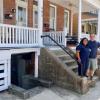Lewes’ signals upgraded, but what about history?
A friend called the other day ranting about the new traffic signal array at the Savannah Road and Front Street intersection in Lewes. For those unfamiliar with Lewes, those traffic signals, at the town's busiest intersection, are the only traffic signals in the entire town.
Out of place is about the nicest thing that my friend said.
I can think of a few more nice things:
The array's industrial-strength construction gives a sense that it will withstand even Category 5 hurricanes.
The traffic signals are clearly visible and safe for drivers.
There's only one pole supporting the entire array, making it a clean and uncluttered installation.
And, snark alert, the supporting mast and street-crossing spar are massive enough that on bright, hot days in the summer they will cast shadows large enough to provide shade for pedestrians waiting to cross the treeless streets there.
Delaware's Department of Transportation installed the array. Lewes Mayor Ted Becker said because of the scenic byway designation in that area, DelDOT offered to upgrade the traffic light arrangement with new fixtures. He said DelDOT also offered to apply a black powder coating to the fixtures, to make them more attractive than the standard galvanized appearance. The town agreed to participate with the extra cost. Becker said he decided to go with that option. The extra cost was, he said, about $3,000.
DelDOT takes care of the signals at the intersection because Savannah Road and the Gills Neck Road, Front Street and Pilottown Road continuum are state roads.
I understand the importance of these intersection signals and the other advantages mentioned above. What I don't understand is the apparent disregard for the context in which the array was placed. That intersection is in the heart of Lewes' historic district. Couldn't the array have been designed to be a little more in keeping with what is generally regarded as a quaint community and one of the state's most historically significant?
Lewes has a set of six core values that are meant to provide guidance to the town's elected officials in their decision-making. The sixth core value states: "Lewes has a unique historical origin and strives to highlight its heritage through building design and architectural preservation." The new traffic installation certainly doesn't enhance that core value. Most would say it diminishes it.
Looking on the sunny side, Mayor Becker said he thinks the black powder coating made the installation more attractive than it otherwise would have been. He also noted the installation includes pedestrian-crossing signals on each of the intersection's four corners. That's definitely a good thing because there has long been a lot of confusion among drivers and walkers about who's supposed to do what there, and when.
He also said DelDOT was immediately responsive when it removed a massive camera-mount pole from one corner of the intersection in late 2017. The pole was quickly criticized after installation for being grossly out of scale when it was first installed.
Becker noted that DelDOT was able to find a use for the pole elsewhere and last week sent in a crew to remove the substantial concrete footing that had been poured as a foundation.
A camera for monitoring traffic and flooding in the area of the Lewes-Rehoboth Canal has been mounted - at a much lower height than on the previous pole - atop the mast installed for the new traffic signals.
DelDOT's explanation
DelDOT spokesman Charles McLeod said the Lewes traffic light installation is DelDOT's "most modern signal structure. We do have different signal structures we can use, however, this is a tight intersection with not much space available on the corners to work with and our traffic safety team determined this to be the best option."
McLeod gathered further information to add to the discussion: "For most new and rebuilt signals, we prefer a mast-arm design which firmly mounts the signal heads over the roadway, as opposed to span wire designs where the signal heads move around in the wind, when trucks drive under, etc. Because the signal heads don't move nearly as much, the wiring tends to last longer as well, and there's less chance of wiring failures.
"The single diagonal mast arm carrying all the signal heads is not preferred. We would rather have a 'box' design where the signal heads 'box out' or surround the intersection. However, we were very constrained in this location due to right-of-way, parking areas, and utility conflicts."
I asked whether DelDOT considers historical context when making decisions on installations such as this.
"We coordinated with both City staff and the Lewes Byways group on this signal design," staffers said. "The original request was from the City of Lewes for improved pedestrian signals. We [DelDOT] decided to fully rebuild the signal due to its age and the preference of mast arm designs, particularly in a higher wind area like this. ... There are two other styles of traffic signal that could possibly be considered here. One is post-mounted signals only, but these are highly undesirable as the signals are not very visible to drivers. Except for a very few low speed/low volume approaches at a few signals around the state, all of our signal heads are overhead. Another style is span-wire design, which is what was previously installed at this location. There's no standard for aesthetics but most feedback received is that the mast-arm design is more attractive than a span-wire design. Lastly, as discussed, we would prefer to have some form of box design with the mast arms, which would involve more poles, but smaller poles. Unfortunately the setting was not conducive to that type of design."
Thanks to DelDOT for its explanation. The total cost of the new installation was $295,000. The pedestrian signals are expected to be fully operational next week.
I don't think switching out the array for gas lights makes sense, but a camo powder coating might help.





















































